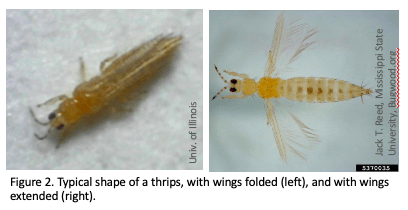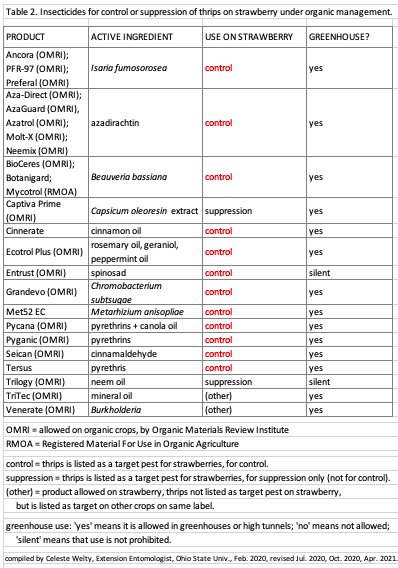Thrips can be a serious pest of strawberries, but they are an occasional pest. This means that in most years, they are not a problem, but in some years, they can be a big problem. The reason for variability from year to year seems to be related to weather systems. In some years, conditions are right that large numbers of small insects such as thrips and leafhoppers blow into Ohio on weather fronts from the southern USA during the time that strawberries are in bloom. In other years, this long-distance movement does not happen at all, or happens later, at a time when strawberries are no longer in bloom. Due to the irregularity in the occurrence of thrips, it is a pest that is well suited to weekly scouting, for early detection of any infestation.
Strawberry fruit that have been injured by thrips are a dull or bronzed color, and are often small, hard, seedy, and fail to ripen (Figure 1). Thrips can cause uneven maturity of fruit. When thrips are abundant and the berry injury is severe, the result can be a strawberry crop that is completely unmarketable. Diagnosis of thrips injury can be tricky because thrips are not the only cause of fruit bronzing. Bronzing can be due to feeding by cyclamen mite or two-spotted spider mite, or to infection by powdery mildew, or to occurrence of low temperatures or hot dry winds, or to pesticide spray effects.
Thrips are often overlooked due to their small size and their tendency to hide in protected places. Thrips are weak fliers but fast runners. Thrips are small, slender, elongate, ‘cigar-shaped’ insects (Figure 2), about 1 mm (1/25 inch) long as adults. They differ from other insects by having narrow strap-like wings that are fringed with hairs. The wings are usually folded lengthwise over their back when they are resting or feeding. The immature thrips are the same shape as adults but smaller and without wings. Thrips have lopsided mouthparts that have a well-developed left mandible and an underdeveloped right mandible. They feed by piercing and scraping plant cells with the mandible then sucking sap that oozes out of the punctured cells.
The thrips species that most commonly infests outdoor strawberries is Frankliniella tritici, which has the official common name of ‘flower thrips’, but which is widely known as the ‘eastern flower thrips’. The adults are yellowish brown, and the immatures are whitish-yellow. The eastern flower thrips does not tolerate cold weather, so does not survive winter well in places like Ohio. The eastern flower thrips has a wide host range that includes many flowering weeds, where the thrips population can build up before moving into a cultivated crop like strawberries.
The eastern flower thrips looks quite similar to three other species of thrips that inhabit Ohio and have been reported from strawberries: the western flower thrips (Frankliniella occidentalis), the tobacco thrips (Frankliniella fusca), and the onion thrips (Thrips tabaci). The western flower thrips is the species commonly found in greenhouses; it is generally much more difficult to control than other thrips because it is usually resistant to most insecticides. In greenhouses, the western flower thrips causes injury to tomatoes, peppers, and cucumbers as well as to strawberries. The onion thrips is best known as a serious pest of dry bulb onions, green onions, and cabbage but is sometimes found on other crops.
Thrips generally prefer to feed on flowers rather than other plant parts, but they can feed on leaves and fruits. On strawberries, the infestation starts by adult thrips being attracted to flowers, and the female inserts eggs at the base of flowers. Each female can lay about 80 eggs. Infestation can continue during fruit set by adults and their immature offspring. Thrips feed on pollen, seeds, and the fruit tissue between seeds. Thrips hide under the cap of the berry or in grooves around the seeds on the berry.
A key to thrips management is frequent monitoring by scouting, at least once per week. Growers should designate one person on the farm to be sure that scouting is done every week. Where multiple varieties are present, each variety should be scouted separately. The scout should begin the season by examining early flower clusters on early cultivars, as soon as the first blossoms open. Scouting should be done in five different areas within small fields or in ten different areas within large fields. In each area, 10 blossoms should be tapped into a white cup, or into a zip-top sandwich bag, which should then be examined for the dislodged thrips running around on the surface. Count the number of thrips found, then calculate the average number of thrips per blossom. The action threshold for treatment with insecticide, used the midwestern USA, is the presence of 2 or more thrips per blossom. This is a conservative threshold that is lower than a threshold of 10 thrips per blossom that is used in some mid-Atlantic and California regions.
Scouting should continue after fruit set, until fruit are ½ inch diameter, by examining 50 fruit in each area, and counting thrips on those fruit. Fruit can be examined in place, or removed and put in a plastic zip-top bag, which can be placed in a sunny location so that the heat forces the thrips to leave their hiding spots and begin running around on the bag surface. Once fruit are ¼ inch in diameter, an action threshold is 0.5 thrips per fruit.
If thrips are above threshold, the trickiest part of management is to avoid spraying insecticide that will harm pollinators. Insecticide should not be applied during bloom, to protect bees and other pollinators. Insecticide should be applied pre-bloom or before 10% of the plants have open blossoms. If thrips are found above threshold on early cultivars, then a preventive spray can be made on the later cultivars before their flowers open, to avoid harming pollinators. If insecticide is needed during bloom, it should be applied in the evening when bees are least active. Sprays targeted at tarnished plant bug or spittlebug or strawberry clipper weevil, just before bloom, often do a good job of controlling any thrips that also are present.
Insecticides used to manage thrips on conventional strawberries include several products that are labelled for control, and several that are labelled only for suppression (Table 1). Products for control of adult and immature thrips are Radiant, Assail, Apta, and Dibrom, all of which have thrips listed as a target pest on their labels. Note that use of Apta on strawberries appears on a supplemental label, not the federal label. A product for control of immature thrips, but not adults, is Rimon. Products for suppression of thrips are Closer, Exirel, Sivanto, Transform, and Verdepryn. In addition, there are several products that are allowed for use on strawberries, but that do not list thrips as a target pest on strawberry, however thrips are a target pest of these products on other crops; these are Admire Pro, Agri-Mek, Brigade, Danitol, Harvanta, Lorsban, and Malathion. Note that Lorsban has a 21-day pre-harvest interval thus is for use only pre-bloom. Beware that pyrethroid insecticides such as Brigade and Danitol are no longer as effective as they were in the past due to the development of resistance in thrips populations at many locations. An adjuvant that can be helpful in control of thrips is Wetcit, which is a penetrant, spreader, and wetting aid.
Products for thrips control on organic strawberries are Entrust, azadirachtin products such as Neemix and Aza-Direct, and the beneficial fungus Beauveria bassiana, as well as other natural products (Table 2).
An important natural enemy of thrips is the Orius predatory flower bug, which is a very small true bug that preys on thrips adults and thrips larvae. Orius insidiosus is a common species in Ohio on many crops; it is frequently found on the moist fresh silks of sweet corn and on flowers of Queen Anne’s lace. There are also several species of predatory mites that prey on thrips. The local population of these natural enemies is often inadequate to suppress thrips, but growers who would like to take a biological control approach to thrips management can purchase natural enemies from commercial insectaries: Orius (predatory flower bugs), and four species of predatory mites: Ambylseius swirskii, Neoseiulus (Amblyseius) cucumeris, Amblydromalus limonicus, and Stratiolaelaps scimitus (formerly Hypoaspis miles). Beneficial nematodes such as Steinernema feltiae are another option. Some suppliers of these natural enemies are IPM Labs, Koppert, BioBest, and Rincon-Vitova. Biocontrol is not feasible to begin once the thrips population is large, but can be planned in advance at locations that have a consistent problem with thrips.
-Celeste Welty, Extension Entomologist



